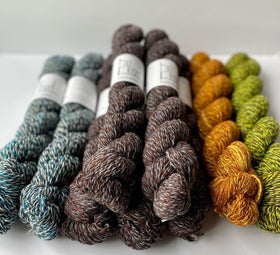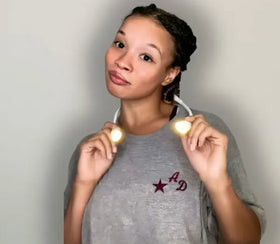
How I learned to love colorwork - Tips for Making Stranded Knitting Easier
By Meg Dedolph
I wasn't always a knitter. I came to the fiber arts through quilting and I was drawn to quilting because I loved the idea of playing with all those beautiful colors.
So it was natural that I wanted to also experiment with colors in my knitting. I adored the look of traditional Scandinavian knitting and Scottish Fair Isle patterns, but I couldn’t get the hang of stranded knitting.
I didn’t like the way the yarns twisted up behind the work, I couldn’t get a good rhythm going between picking and throwing, and the whole endeavor left me at a loss. I loved the projects, but I hated making them.
Except the last couple of years, I’ve found myself casting on multicolor projects and I’m thrilled with them.
What happened? I’ll tell you.
Try some new techniques
Maybe launching into a steeked stranded-colorwork sweater was not the way for me to learn to love colorwork knitting. How did I realize this? It still needs a sleeve and a half - more than a decade later.
However, there are lots of ways to enjoy playing with colors and beautiful yarns that aren’t stranded knitting.
This family of garter-stitch shawls, scarves and mittens, which are based on short rows, are captivating to me right now and appeal to my love of scrappy patchwork quilts.
Two great multicolor techniques to try out are mosaic knitting, which involves only slipping stitches, knitting and purling; and helix knitting, which is a great way to make single-row stripes for in-the-round projects, such as hats, mittens or socks. The more colors you add, the more stripes you get.
All of these are fun to figure out, especially in heavier-weight yarns. Which brings me to ….
Worsted and DK weight yarns
Just because the traditional knitting of the Shetland Isles involves two-ply fingering-weight wool on similarly small needles, doesn’t mean that’s the only place to start. One of my favorite colorwork projects last year was a worsted-weight cowl done with Plied Penn Ave. and Rios.

Dip your toes in
Speaking of two-color worsted-weight cowls, small projects are a great way to see if you like a technique before you commit to a bigger project – or a smaller gauge.
Try a cowl or a pair of mittens. Do something fancy to a sock cuff or make a hat. Make a hat band and then knit the rest plain.
If you love colorwork sweaters, consider a patterned yoke sweater with a plain body. Or try a baby sweater; all the techniques in a fraction of the size.
One of the projects I first tried two-color stranded knitting on is the pumpkin hat, a terrific quick fall baby gift with just a handful of two-color rounds. (I like it in Rios, but Emily has made some great hats in Rasta, too.) No fall babies in your orbit? It's cute in red, yellow, green, pink ... any produce-section color.

I feel like smaller projects are easier for me to take risks with color on. It doesn’t feel as intimidating to experiment and that’s more fun.
Hello, “faux isle”
So, back to those gorgeous Scottish colorwork patterns, which sometimes take eight or nine carefully blended colors to achieve.
If that feels like a lot (picking out two colors can be hard enough sometimes!) what about “faux isle,” where you knit a beret or sweater yoke with a background color and a self-striping or gradient yarn for the contrast. Let some clever yarn-dyer do the hard work for you. Here's a great example from Knitty.
I’ve recently been enjoying some two-color hats with gradient and variegated yarns for contrast and I'm having a great time.

Get a couple tips
I knit by carrying my yarn in my left hand, so carrying one color in each hand wasn’t fun for me. I tried carrying two colors in my left hand, but it was hard to pick up the correct strand with my needle.
Then I tried a colorwork thimble, which makes it easier to carry two colors in my left hand and I’m much happier with my knitting technique.
The other feature of knitting with lots of colors is having lots of ends. Then I found the “Weavin’ Stephen” video on YouTube by Stephen West, and now I have a good way to weave in ends as I go.
Try some new techniques, try thicker yarns, take advantage of the gorgeous self-striping and hand-dyed yarns out there, and you too could move from a colorwork-skeptic to a color-knitting enthusiast!




Leave a comment